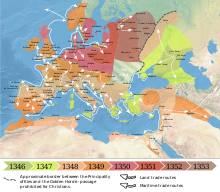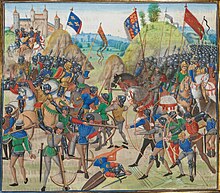Note: if you are going to watch The Last Duel(2021) then you might not want to read all this until after you watch the movie.
I was watching The Last Duel(2021) starring Matt Damon and Ben Affleck who also wrote the parts of the movie that they were starring in the most. They also hired a Lady writer to write Marguerite's point of view too.
It said that Jean (Marguerite's previous wife and children died in the Black Plague which allowed him to be free to Marry Marguerite who was much younger than him at the time.
So, I looked up the Black plague and the date it first arrived in France that killed the real Wife and children of Jean, the squire who became a French Knight during this movie. So, I found out it arrived in France on a ship in 1347 when it first started killing people in France. The spoke during the movie how it killed about 1/2 of the serfs that farmed Jean's fields which was why he was having money problems and needed a rich dowry from his young wife to make things work.
I also found it interesting that when Jean was finally made a Knight of the King of France that he wore a golden medal which showed he was one of the King's Knights on a chain or ribbon ever after to designate him permanently as a knight of France.
begin quote from:
https://en.wikipedia.org/wiki/Black_Death_in_France
Black Death in France
The Black Death was present in France between 1347 and 1352.[1] The bubonic plague pandemic known as the Black Death reached France by ship from Italy to Marseille in November 1347, spread through first Southern France and then Northern France and, due to the size of the Kingdom, lasted there several years, as some parts were not affected until the plague was over in others. The Kingdom of France had the largest population of Europe at the time, and the Black Death was a major catastrophe. The Black Death in France was described by eyewitnesses such as Louis Heyligen, Jean de Venette and Gilles Li Muisis. The Black Death migrated from Southern France to Spain, from Eastern France to the Holy Roman Empire, and to England by ship from Gascony.[1]
At the time, Pope Clement VI resided in Avignon in present-day France during the Western Schism, and issued his condemnations of the Jewish persecutions during the Black Death as well as the flagellants.[1] During the Black Death in France, King Philip VI of France ordered the University of Paris to compose the pioneering work Compendium de epidemia due to the pandemic.[2]
Background[edit]
France in the mid-14th century[edit]
At this point in time, France and England had entered the Hundred Years' War. In 1346, France had lost the Battle of Crécy. Pope Clement VI lived in Avignon in present-day France during the Western Schism.[3] The Kingdom of France had a population of between 16 and 20 million people, the largest population of Europe. Similarly to Italy, it was relatively urbanised.[1]
The Black Death[edit]
Since the outbreak of the Black Death at the Crimea, it had reached Sicily by an Italian ship from the Crimea. After having spread across the Italian states, the plague reached France by a plague ship in November 1347.[1]
Plague migration[edit]
Southern France[edit]
The plague in Southern France are described by Louis Heyligen in Avignon. According to Louis Heyligen the Black Death reached France in December 1347, when a Genovese plague ship from the East was forced to leave its home port of Genova shortly after its return and arrived in Marseilles instead.[1] The ship spread the plague in Marseilles, was forced to leave the city and continued on its way along the coast of Southern France, spreading the plague along its way, as well as from Marseilles West toward Toulouse, and north toward Avignon.[1] In May 1348, a second wave came by land from Genova.[1]
In Avignon, the pope arranged religious processions to dampen the wrath of God, as the plague was interpreted by the church as the punishment of God for the sins of humanity.[1] The pope was advised by his physician Gui de Chauliac to hide from the plague in Étoile-sur-Rône, where he survived the outbreak.[1]
The Black Death in Southwest France is not as documented as it is in Avignon. It is noted to have been in Carcassonne in January 1348 and in Toulouse in April. It is confirmed in Bordeaux in June 1348, but it is likely to have been present there already in March. It is noted that it was a ship of pilgrims from Bordeaux who brought the plague to Santiago de Compostela in Spain. [1]
In April 1348, the Black Death is noted to have reached Lyon.[1]
Northern France[edit]
From Lyon, the plague spread across Burgundy. In the village of Givry in Burgundy, half the population is confirmed to have died in August-November 1348. [1]
The Black Death in Paris is described in the famous chronicle of the Carmelite Jean de Venette in the Saint-Denis Abbey in Ille de France outside of Paris. At the time, Paris was the biggest city in Europe, with a population of between 80.000 and 200.000 people.[4] According to Jean de Venette, the plague first arrived to Roissy near Gonesse in June 1348. He claims, that 16.000 people died in Saint-Denis and 800 people daily in Paris between November and December, were 500 died was transported to mass burial each day from the Hôtel-Dieu, Paris, were the nuns who attended the sick died along with them.[1] It did not leave Paris until January 1349.[citation needed]
The presence of the plague is noted in Rouen in Normandie in the Normanniae nova Cronica during the feast of John the Baptist on 24 June 1348. In Normandie, the plague made it impossible to bury the corpses even in country villages, and each village which was reached by the plague flagged a black flag to warn anyone approaching.[1]
In the very Northern parts of France, the Black Death is described in the chronicle of the abbot Gilles li Muisis of Tournai. According to Li Muisis, the plague reached Tournai in August 1349 and lasted to November. In Tournai, the Black Death caused a religious reformation. Because the plague was seen as punishment of God for the sins of humanity, the authorities issued regulations to ban everything regarded as sinful, such as gambling, and forced couples who lived together without being married to separate or marry immediately.[1]
Due to the size of France, certain parts were not immediately reached by the plague, which travelled more slowly by land than by sea. Brittany and Auvergne were not reached until 1349, and some remote parts were not reached until 1351. The last part of France to be reached by the Black Death was Tonnerre, which was not reached by the Black Death until 1352.[1]
Consequences[edit]
When the plague spread across Southern France, king Philip VI of France ordered the University of Paris to compose the pioneering work Compendium de epidemia due to the pandemic.[5]
The migration of the plague caused panic across France, and people started looking for scapegoats. Rumours started to spread that the plague was caused by people who poisoned the wells to cause the plague and exterminate Christendom. Initially, these accusations were not directed at people of any particular category, but directed at anyone who appeared suspicious simply because they were different or unidentified, particularly travellers (such as pilgrims and beggars) invalids, or people in possession of any kind of powder.[1] In April 1348, Louis Heyligen reported that people were executed for well poisoning in Avignon; the same month, Andre Benezeit, secretary of mayor Aymar of Narbonne, reported to the mayor of Gerona in Catalonia that many beggars had been arrested, tortured and executed in Narbonne, Carcassonne and Grasse for well poisoning.[1]
These accusations were eventually also directed against the Jewish population, and on 5 July (and again on 26 September) Pope Clement VI issued his condemnations of the Jewish persecutions during the Black Death and explained that since the plague was a punishment issued by God himself, it was sinful to accuse the Jews of having caused it, and declared the Jews to be under his protection.[1] While there is not much information about the Jewish persecutions during the Black Death in France, were the Jewish population was small due to the fact that Louis IX of France had banned them from France, the well-poisoning rumours from France erupted into documented persecutions and mass executions in the Duchy of Savoy, and resulted in massacres in the Holy Roman Empire, where the Jewish population was larger.[1]
Recurrences[edit]
The Black Death would return regularly, but with fewer death victims, until the 18th century. The last epidemic of bubonic plague in France was the Great Plague of Marseille in 1720.[6]



No comments:
Post a Comment